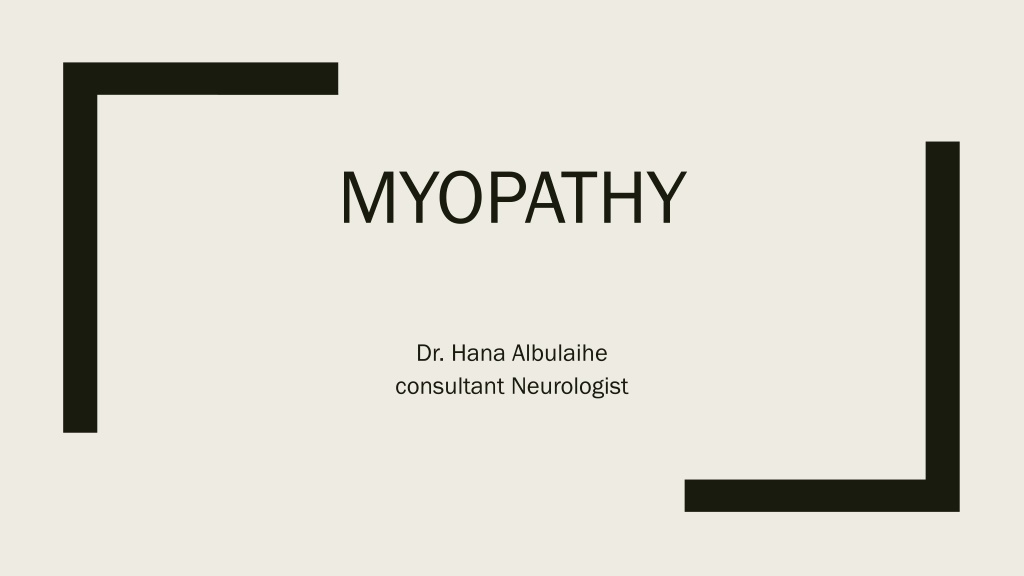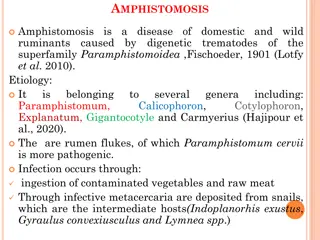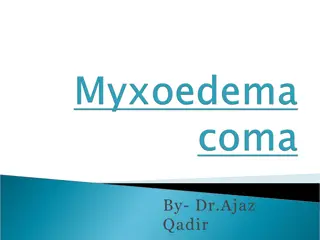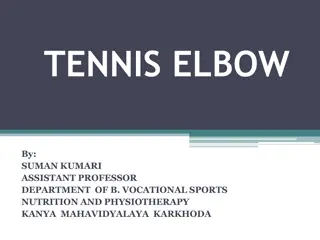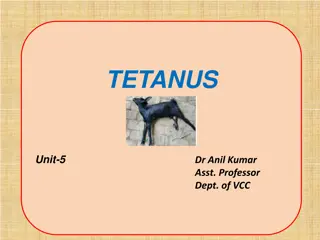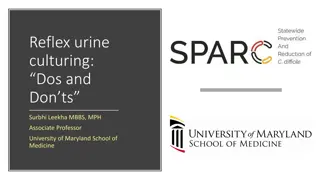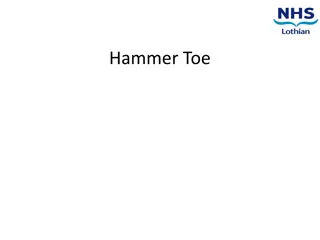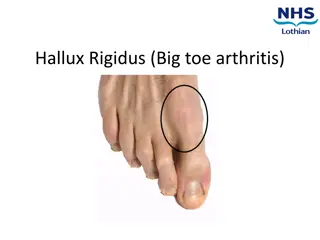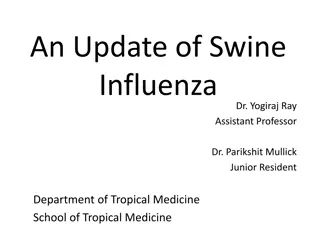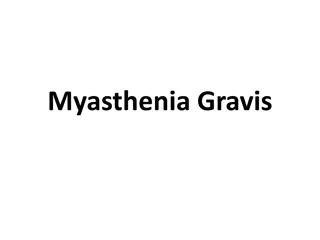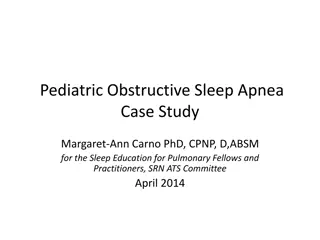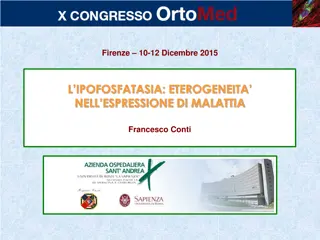Understanding Myopathy: Symptoms, Diagnosis & Management
Myopathy is a condition characterized by primary impairment in skeletal muscle function or structure. Dr. Hana Albulaihe, a consultant neurologist, explains the approach to evaluating patients with weakness complaints, distinguishing between myopathy and non-myopathic conditions, and common symptoms like weakness, myalgia, and myotonia. Proximal leg weakness can result in Gower's Sign. Understanding the onset, progression, and distribution of weakness is crucial in diagnosing and managing myopathy effectively.
Download Presentation

Please find below an Image/Link to download the presentation.
The content on the website is provided AS IS for your information and personal use only. It may not be sold, licensed, or shared on other websites without obtaining consent from the author. Download presentation by click this link. If you encounter any issues during the download, it is possible that the publisher has removed the file from their server.
E N D
Presentation Transcript
MYOPATHY Dr. Hana Albulaihe consultant Neurologist
MYOPATHY MYO- is muscle , pathos is suffering in Greek. Disorders in which there is a primary functional or structural impairment of skeletal muscle.
Approach to myopathy The evaluation of the patient presenting with a complaint of weakness involves the following steps: Distinguishing true muscle weakness from asthenia or motor impairment not due to loss of muscle power. Localizing, within the neuromuscular system, the site of the lesion that is producing weakness. Determining the cause of the lesion
Distinguishing between myopathy and non myopathic pain or weakness is the first step in evaluating patients with muscle-related complaints. SOB, joint pain, fatigue, poor exercise tolerance or paresthesia, rather than a true muscle weakness.
Symptoms: Symptoms: Positive symptoms: Positive symptoms: Myalgia Myotonia. Cramps. Contractures. Myoglobinuria.
Negative symptoms: Weakness. Atrophy. Exercise intolerance. Periodic paralysis.
Weakness Weakness is a cardinal symptom. The distribution of weakness is variable and may change over time. Complaints such as difficulty arising from a chair or low toilet, difficulty climbing stairs, a waddling gait, difficulty lifting objects over the head, combing hair or brushing teeth. Distal weakness is less common.
Weakness Patients with proximal leg weakness may rise from sitting on the floor by climbing up their legs with their hands. This is called Gower s Sign .
Weakness Onset. Course. Limbs involved. Muscle involved. Progression. Presence of sensory/ autonomic symptoms.
Weakness Define pattern of weakness: Proximal limb girdle. Distal distribution. Scapuloperoneal distribution. Distal arm and proximal lower limb. Associated symptoms: ptosis / ophthalmoplegia / cardiac/ respiratory.
Exercise intolerance A less reliable negative symptom. Often reflects the general level of conditioning and health. In patients without any objective weakness, depression should be considered.
Exercise intolerance Exclude certain metabolic myopathies or mitochondrial cytopathies. Ask if it is elicited by brief or long term exercise (carbohydrates or lipid metabolism).
Myalgia Infrequent symptom. Orthopedic or rheumatologic conditions are more frequent causes. Constant proximal muscle pain often accompanies inflammatory myopathies. Episodic myalgias after exercise point to metabloic myopathies. In patients with waxing and waning diffuse myalgias, anexity should be ruled out.
Cramps Involuntary contractions of muscle that last for seconds to minutes. Most are benign and occur predominantly in calves. Risk factors are old age, dehydration, prolonged sitting, use of diuretics, hypothyrodism and DM. They are most common in motor neuron disease and chronic neuropathies rather than myopathies. Cramps are only common in metaboic.
Myotonia Impaired relaxation after sustained voluntary contractions. A painless phenomenon. Commonly involves intrinisic hand muscles and eyelids. It is due to repetitive depolarization of the muscle fibers. It improves with repeated exercise.
Myotonia Clinically myotonia can be seen by tapping the muscle ( percussion myotonia) or by voluntary contractions of muscle groups ( action myotonia). Typical tests are squeezing the hand of the examiner or forceful closure of the eye.
Myoglobinuria Excess myoglobin in urine resulting in a cola colored urine. It is an uncommon finding. Severe and relatively acute muscle fiber damage.
Myoglobinuria Causes: Causes: Idiopathic. strenuous exercise. Drugs or toxin intake. Infections. Heat stroke. In case of recurrent myoglobinuria, glycogenoses, lipid storage myopathies or central core disease with malignant hyperthermia should be ruled out.
Lab investigations: *Muscle enzymes: *Muscle enzymes: CK. Aldolase. LDH. Aminotransferase. *ANA, ENA antibodies( anti Ro/SSA, anti La/SSB, anti Sm, and anti RNP)
Lab investigations: Myositis specific antibodies ( anti-histidyl-t-RNA aynthase anti Jo-1 ). Genetic testing.
Electromyography: Electromyography: Electrodiagnostic technique for evaluating and recording the electrical activity produced by skeletal muscles, the signals can be analyzed to detect abnormalities.
MRI Muscle biopsy.
Congenital myopathies. Muscular dystrophies. Channelopathies. Metabolic myopathies. Mitochondrial myopathies. Inflammatory myopathies. Toxic, metabolic and infectious.
Congenital myopathies Clinical characteristics present from birth or prenatally. Prenatal: decreased fetal movement. Postnatal: hypotonia, poor respiratory effort, difficulty feeding, reduced muscle bulk, weakness. First year and beyond: hypotonia, weakness, delayed milestones, failure to thrive, recurrent respiratory infections, flaccid speech. Slow or non progressive course.
Congenital myopathies Central core disease. Multicore (minicore) disease. Nemaline myopathy. Myotubular (centronuclear) myopathy. Myofibrillar myopathy. Congenital fiber type disproportion.
Congenital myopathies Managemet Managemet: : Genetic counseling. Detection and treatment of orthopedic complication. Prevention of complications ( general anaesthesia).
Malignant hyperthermia Hypermetabolic crisis. MH- susceptible individual is exposed to a volatile anaesthetic or succinylcholine. Genetic skeletal muscle receptor abnormalities allowing excessive calcium accumulation in the presence of certain anaesthtic triggering agents.
Malignant hyperthermia Symptoms: Symptoms: Masseter spasm immediately following anaesthetic induction. Hypercarbia. Sinus tachycardia. Generalized muscular rigidity. Tachypnea. Cyanosis.
MH Rapidly increasing temperature is a later sign of MH and is typically absent when the diagnosis is initially suspected. Sweating Cola- colored urine. Ventricular fibrillation.
MD Inherited myopathies. Variable age at onset. Progressive degeneration of the muscles with connective tissue replacing muscle fibers. Systemic involvement.
MD Dystrophinopathies ( Duchenne and Beker). Emery- Dreifuss muscular dystrophy. Autosomal dominant dystrophies: * fascioscapulohumeral MD. * Oculopharyngeal MD. * Congenital and proximal myotonic dystrophy. Limb girdle MD.
Dystrophinopathies X linked recessive disorders. Duchenne and becker (DMD, BD). Caused by mutation in the dystrophin gene. Dystrophin provides mechanical reinforcement to the sacrolemma and stabilizes the glycoprotein complex. Its absence causes digestion of the glycoprotein complex. This initiates degeneration of the muscle fiber resulting in muscle weakness.
Duchenne MD (DMD) Motor developmental delay. Toe walking, as a compensation for the progressive weakness of the knee extensors. Difficulty rising from sitting position. Gower s sign. Lumber lordosis, waddling gait, pseudo-hypertrophy of the calves. 12 years: loss of ambulation, marked wasting of muscles, contractures, kypho-scoliosis, exaggerated lumber lordosis. Death due to respiratory complication between 15-30 years.
DMD Systemic involvement: Systemic involvement: Cardiomyopathy: CHF and arrhythmias. Malignant hyperthermia like reactions with rhabdomyolysis. Intestinal pseudo-obstruction. CNS involvement: mental retardation, learning disabilities.
DMD Investigation: Investigation: CK is markedly elevated early in the disease. Electromyography: myopathic potentials. Muscle biopsy: necrosis, replacement with connective tissue and fibrosis, variation in muscle fiber size, absent dystrophin.
DMD Management: Management: Early detection of systemic involvement: Assessing for evidence of cardiac dysfunction and treatment accordingly. Screening for orthopedic complications to maintain function and prevent contractures. Dietary calcium and vitamin D supplementation, and yearly DXA scanning. Weight and growth monitoring. Avoidance of anaesthesia and sedation if possible.
DMD Glucocorticoids are the mainstay. Boys 5 years and older who are no longer gaining motor skills or whose motor skills are declining. It increases strength, muscle and pulmonary functions. Reduces cardiomyopathy and lower mortalitiy. Has an anabolic action in contrast to its catabolic action on normal skeletal muscle in unaffected people. Stabilizes sacrolemma.
DMD Side effects: Side effects: Weight gain. Cushinoid facial appearance, acne. Short stature, compression fracture. Delayed puberty. Excessive hair growth. Gastrointestinal bleeding. Psychosis and behavioral changes.
Becker Dystrophy Older age at onset. Less severe symptoms. Loss of ambulation is usually in the 4thdecade. Muscle biopsy shows decreased staining patterns rather than complete absence of dystrophin.
Myotonic dystrophy (MD) The most prevalent inherited neuromuscular disease in adults. Autosomal dominanat. Age of onset average is 29 years. Myotonia. Weakness of the forearms and peroneal muscles. Ptosis and weakness of other facial muscles.
MD Frontal bolding. Mild axonal neuropathy. Heart involvement. GIT dys-motility, constipation and diarrhea. Cataract. Endocrine abnormalities. Low IQ.
